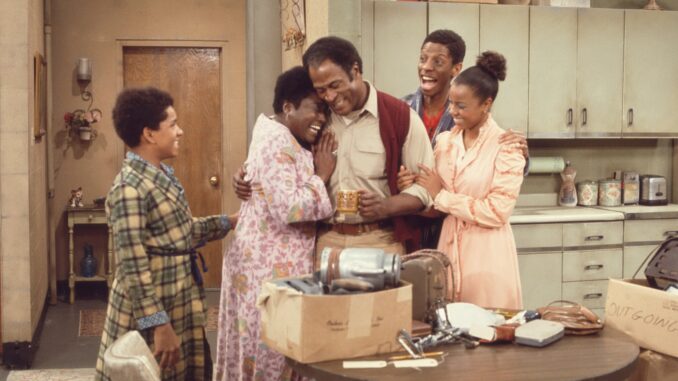
“Good Times,” “The Jeffersons” and “Sanford and Son” brought a wave of Black characters to TV, even as the shows opened up over stereotypes.
As a birthday present for Tyler Perry last year, a mutual acquaintance arranged for him to meet one of his heroes, Norman Lear. Perry grew up watching Lear’s groundbreaking television shows, and was awed by how several presented a fuller version of Black lives onto American television screens for the first time.
Long ago, Perry had hoped to have a storied career that would emulate a speck of what Lear’s shows such as “Good Times” and “The Jeffersons” displayed: that Black people can share opinions, fall in love, laugh and be afraid just like anyone else.
“Had it not been for Norman, there wouldn’t have been a path for me,” said Perry, whose film and TV empire has made him one of the most powerful figures in Hollywood. “It was him bringing Black people to television and showing the world that there’s an audience for us.”
Perry departed his meeting with Lear, who was 100 years old at the time, with a deeper appreciation for the craftsmanship of the budding television writer and producer who died at 101 on Tuesday. The reality of Lear, a white man, being responsible for bringing a fuller picture of Black lives to American TV screens was a product of the era, when most doors were still closed to Black producers and creators. Some characters in his shows were the source of flare-ups, especially when some Black cast members complaining about stereotypical portrayals, which are still debated today.
Yet despite the anxiety, it’s hard to find anyone in the medium of television who is held in such high regard, including by many Black writers and showrunners now creating and running today’s shows.

“It’s like asking someone who played basketball if Michael Jordan influenced them,” said Kenya Barris, the creator of “black-ish.” “He changed the way contemporary storytelling was told in the genre that I was doing it in.”
Barris said that Lear was an early champion of “black-ish” and even visited its writers’ room in 2016.
“It’s about as impactful in modern media as a legacy could be,” Barris said of Lear’s body of work that made him a defining figure of ’70s TV.
Lear’s shows touched on hot-button issues such as civil rights activism, alcoholism and abortion, going far beyond the one-dimensional existence that Black characters were previously relegated to. His shows depict television’s first two-parent Black family, an upwardly mobile Black family and the other side of the coin to his most famous character, “All in the Family’s” Archie Bunker, in Redd Foxx’s portrayal of the oft-bigoted Fred Sanford in “Sanford and Son.”
This full-rounded view of Black life in America — through characters who had failures and triumphs, struggles and struggled — helped usher in what historians call the era of “social relevance” in television, in which TV shows and sitcoms offered more authentic depictions of Americans’ lives, said Adrien Sebro, an assistant professor at the University of Texas at Austin and author of “Scratchin’ and Survivin’: Hustle Economics and the Black Sitcoms of Tandem Productions,” a book about Lear’s many television productions.
Beverly McIver, an artist and professor of art history and visual studies at Duke University, remembers watching Lear’s shows every week as a child. Growing up in a housing project in Greensboro, N.C., she identified with J.J. Evans, the teenage aspiring artist who grows up in Chicago public housing, portrayed by Jimmie Walker on “Good Times.”
“These shows gave me hope that I could rise out of the project, not continue the cycle of poverty, and that I could be an artist,” she said.
Walker, in an interview, said Lear always looked to deliver a message through his shows, which initially threw Walker.
“Norman, if you want to deliver a message, go work for Western Union,” Walker, 76, recalled telling Lear. “I’m here to work. I’m here to have fun, baby. I’m here to do comedy.”
